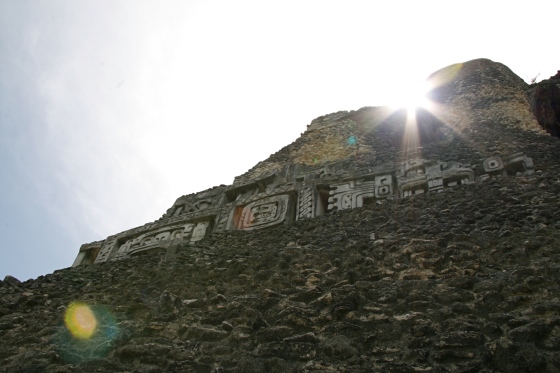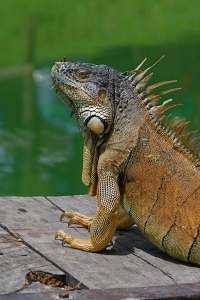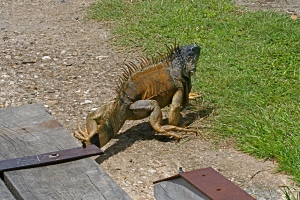According to belizetourism.com, “If you visit only one Maya ruin in Belize, it should be… Xunantunich.”
After our laid back evening on the streets of San Ignacio, our hunger ignited by fragrant street market mangos, papayas and Belizean chicken, we were too tired to cobble together a street picnic.
So, we found ourselves on the outskirts of the jungle, spreading white linen napkins across our bug-doped legs at a country club-like steak house, called the Running W. At the top of the menu? A $26 Belizean-/$15.50 American -dollar steak tenderloin. I giggle now, thinking of our current six-month flirtation with veganism. (But that’s another story.)
In the morning, we bid the Log Cab-Inn—with its reversed hot and cold knobs, 3-inch roaches, wobbly toilet, exposed wiring, and minimal sheets, towels and pillows (above average for Belizean back country accommodations)—goodbye and headed down the road to Xunantunich.
 Eight miles from San Ignacio, we motored into the village of Jose Succotz, so small, by the time you say Xunantunich (zshoo-NAN-too-NEECH) you’ve missed it. Here we loaded our pimped-up-ride onto Belize’s second, hand-cranked ferry—with its fifteen-pound, attendant Iguana—and crossed the Mopan River on our way to Belize’s most impressive Mayan ruin.
Eight miles from San Ignacio, we motored into the village of Jose Succotz, so small, by the time you say Xunantunich (zshoo-NAN-too-NEECH) you’ve missed it. Here we loaded our pimped-up-ride onto Belize’s second, hand-cranked ferry—with its fifteen-pound, attendant Iguana—and crossed the Mopan River on our way to Belize’s most impressive Mayan ruin.
The Maya originated in the Yucatan around 2600 B.C. This civilization peaked around 250 A.D. in Guatemala, southern Mexico, western Honduras and northern Belize with over 2,000,000 citizens. The ruins they left behind inspire many questions.
Entering the plaza ruins, towering pyramid-like structures required we throw our heads back to take them in.  The tallest pyramid, El Castillo at 130 feet, is large by Mayan specs, only surpassed in size by the Caana structure at neighboring ruin Caracol.
The tallest pyramid, El Castillo at 130 feet, is large by Mayan specs, only surpassed in size by the Caana structure at neighboring ruin Caracol.
The guide pointed to a swath of Mayan figures carved into El Castillo: “The exposed frieze is actually a fiberglass replica,” he said. I felt disappointed until I realized this is only one small fraction of the pyramid, and the fiberglass protects the real frieze underneath. A stickler for authenticity, I never would have known had he not said anything.
As we ascended the three-foot-high, hand-carved steps, I imagined the hands that chipped away at each boulder. The immense stairs weren’t made for walking. I needed to clutch each step to pull myself up. Flooded with a sense of smallness in the face of this effort, I wondered about the Mayans.
At nine-years-old, Ilse was probably closer in size to the original Mayans who built this place. While she and her father disappeared up a zigzag of steps off the back of the pyramid, Lena and I turned back to tackle the front side for a photo opp. My tiny, 6-year-old, Lena hiked up her dress, hoisting one leg up each step as if climbing onto a horse. She didn’t complain. FOR. THIRTY. STEPS!
 I hugged the rock steps inspecting each crevice for a sign that might point to a day thousands of years ago: a stain? A stone tool? A thought discarded by the universe? Whose sweat before mine salted these rocks?
I hugged the rock steps inspecting each crevice for a sign that might point to a day thousands of years ago: a stain? A stone tool? A thought discarded by the universe? Whose sweat before mine salted these rocks?
Belize.com explains:
…certain temples were positioned so that precise observations of the equinox, solstice and other astronomic events could be made by sighting plants and stars along defined line positions on special buildings.








One school break our family and another family of four with two teenage girls to match our own, traveled through Arizona. Although not nearly the size of the El Castillo, Toozigut and Montezuma’s Castle were, to me, the most beautiful structures I had ever seen. The occupant’s disappearance is, like the Mayans, a mystery. I would walk around with awe, taking note of each well placed stone, and using my imagination to recreate the life that once occupied the walls. Amazingly, after days of traveling to visit different native american sites, peering down to the bottom of meteor crater, walking through a ghost town (Jerome, which is no longer a ghost town!), we did not visit the one site that Arizona is most known for: The Grand Canyon!
LikeLike
Great anecdote! You’re spot on about Arizona’s ruins as well, and to think “What happened?” “Where did the ancient people go?” and “What kind of work occupied their daily lives?” Yes! All those great locations in AZ and to miss the Grand Canyon!? Well described Lisa! – Renee
LikeLike
Renee, thank you so much for taking me on your journey. I love how the text and the photographs work together. Really lovely! As for my travel moment, it was when my 11 year old daughter and I were in a flooded windowless bathroom in Pisa. We had been waiting hours for a bathroom and both had on tight jeans (after those wonderful Italian meals). The toilet was a hole in the floor. We were trying not to sink ankle deep in the puddles of the uneven floor. In order to do so one of us had to hold the other to keep her balance hovering over the seat, jeans down at the knees. It was when I was doing the hovering that the power went out. We didn’t get out of there with dry feet, and that’s when I realized how spoiled we are that we take our amazing bathrooms for granted. Sorry it’s not more profound!
LikeLike
Luanne, not so sure this isn’t profound! The image of two woman, mother and daughter, you capture here is such a neat image metaphor… with Pisa leaning in the background… the two of you leaning… such vulnerability and potential hilarity wrapped up together! Thanks for the share! -Renee
LikeLike
Renee, I’m pretty sure you just translated a moment to forget into a moment that matters! That’s a beautiful idea about the tower!
LikeLike
It’s all there… you just need to do what you do so well: literary tinkering! – Renee
LikeLike
Nice review! You’re on the Cayo Scoop!
http://www.scoop.it/t/best-of-san-ignacio-cayo/p/2145915321/xunantunich-climbed-and-reviewed
LikeLike
Cool! I will look for this reblog (?). Happy travels, Renee
LikeLike
The never ending wonders of Belize told beautifully by my ole talented singing partner!.. ..
LikeLike
Sweet John! Nice to hear from you in ole Illinois. How’s the weather up there?
LikeLike
It looks awesome. What a fabulous trip.(Phillipa)
LikeLike
Phillipa thanks for checking it out!
LikeLike
Such a cool place – I love your thought: I hugged the rock steps inspecting each crevice for a sign that might point to a day thousands of years ago: a stain? A stone tool? A thought discarded by the universe? Whose sweat before mine salted these rocks?
I’ve always thought of Belize as just a ‘beach’ vacation spot – I’d rather check out ruins than lay on a beach – maybe next time my wife wants to hit the beach resorts we can head down here since it looks like there is a lot of non-beach activities I can partake in.
LikeLike
Thank you so much for the close reading. I’m thrilled that moment caught your attention… it arrested mine as well — while there and while recalling! Belize offers so much for everyone: upscale areas, archeology, jungle, deep sea/pelagic fishing, shallow snorkeling, back country jungle, diving, mountainous and coastal regions… keep watching: I will post more, later, on Belize. Your typical beach party stuff can be found at Ambergis Caye. On the blog, I want to get to some other stuff right now. But, yes, you’re right, it’s much much more than a “beach” spot. Check out lodges in interior: SEven Sisters… if you want upscale check out the Coppola, as in Director Francis Ford, series of resorts… they are near the upper end if that’s where your travels take you for accommodations: Blancaneaux Lodge, Turtle Inn, La Lancha
http://www.coppolaresorts.com/blancaneaux/
LikeLike
Another lovely portrait of Belize. When I visited Peru last year, I recall thinking about many of the questions that you raise here. I’m particularly taken with the sense of community that existed and all the work that was performed for the common good versus the individualism that we face today.
LikeLike
Thanks Tammy. You suggest an interesting question. How did cultures evolve from community emphasis to that of the individual? Was individualism more human nature or culturally based? Would love to know more about your Peru travels! – Renee
LikeLike
The Mayans built quite a culture. I have visited other ruin cities made the the Mayans, but I have never been to Xunantunich. Looks like an awesome place – and it’s pretty clear you had a good time. Thank you for sharing the experience.
LikeLike
Much appreciated coming from a fellow-traveler! You’d enjoy the back country route to get there given the paths you follow in your photoblog!
LikeLike
very impressive buildings and a fascinating history, thx for the pics
LikeLike